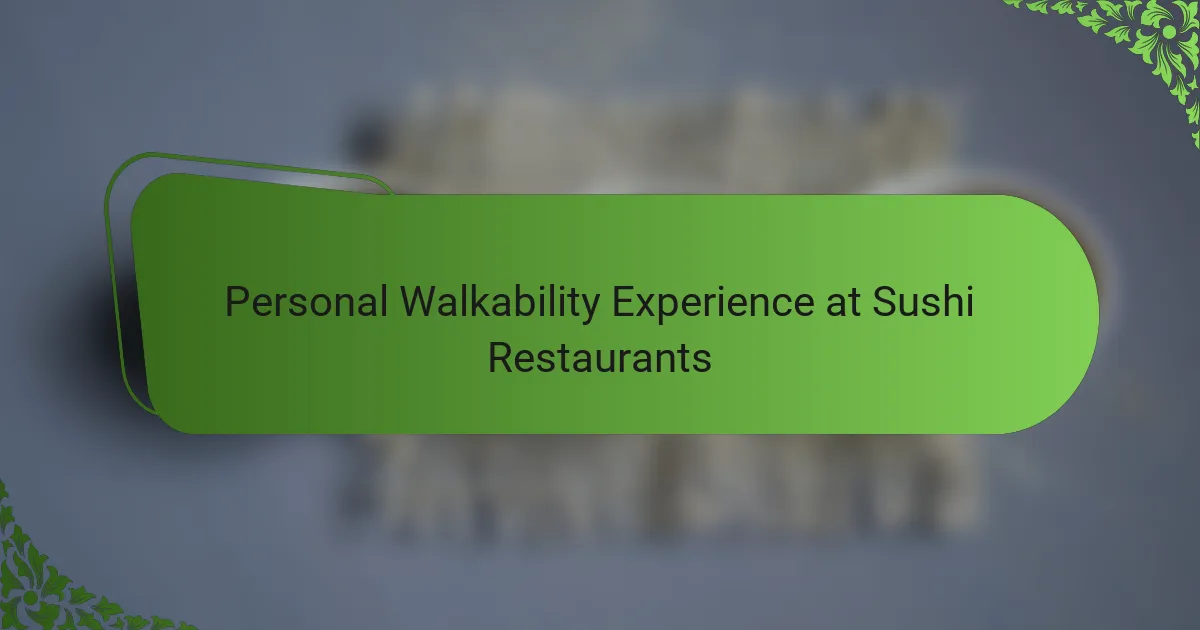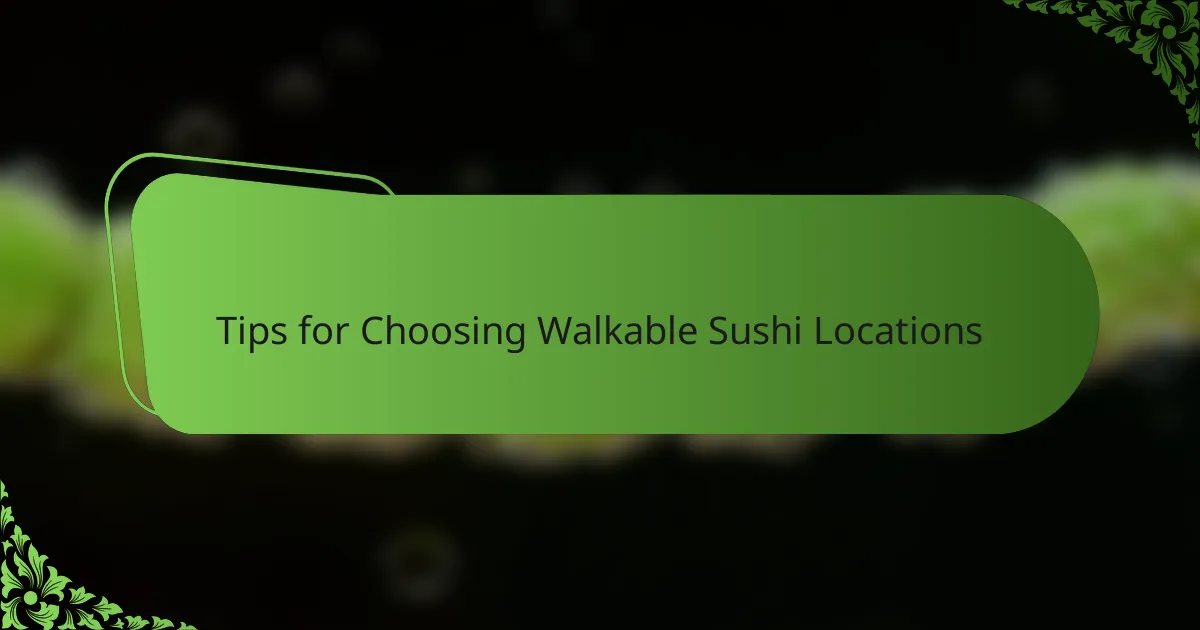Key takeaways
- Walkability enhances the overall dining experience, influencing mood and anticipation before the meal.
- Neighborhood layout, safety, and accessibility significantly impact the walk to restaurants, shaping diner satisfaction.
- A pleasant walking environment fosters a sense of connection and encourages diners to linger and explore post-meal.
- Insights on walkability can lead to more enjoyable visits and opportunities to discover nearby attractions.

Understanding Walkability in Restaurants
Walkability in restaurants goes beyond just how close a place is; it’s about how easily and comfortably you can get there on foot. I often find myself considering whether a restaurant is nestled in a pedestrian-friendly neighborhood or tucked away in a spot that makes you dread the walk. Have you ever chosen where to eat based on how pleasant the stroll would be? That small detail can shape the whole dining experience.
For me, walkability shapes the anticipation of a meal. Arriving with fresh air on your face and no stress from traffic sets a positive tone before the first bite. It’s surprising how much a simple walk can enhance your connection with a restaurant’s vibe, influencing not just what you eat but how you feel while eating. Isn’t that worth paying attention to when picking where to satisfy your sushi cravings?
Sometimes, I reflect on the times I’ve hurried through busy streets or awkward parking lots just to reach a ramen spot. It made me realize walkability is part of hospitality—it’s about respecting the diner’s journey, not just their appetite. When restaurants prioritize walkability, they’re inviting you to enjoy the entire outing, not just the meal at the end. Doesn’t that change how you see a dining destination?

Factors Affecting Walkability Near Sushi Spots
One big factor that comes to mind is the layout of the neighborhood. I remember trying to walk to a sushi place once, but uneven sidewalks and a maze of busy intersections turned what should’ve been a pleasant stroll into a frustrating trek. It makes me wonder—how much does the city’s design sneak into our dining decisions without us even realizing it?
Lighting and safety can’t be overlooked either. I’ve noticed that sushi spots in well-lit, lively areas make me feel relaxed and more eager to walk there, even at night. When the surroundings feel welcoming, the walk becomes part of the excitement, not a reason to call a ride.
Accessibility plays a huge role too—things like clear signage, seating benches, or even nearby transit stops. On a chilly day, seeing a bus stop just a few blocks away gave me a warm sense of relief, knowing I had options if I got tired. Have you ever found yourself pausing because the walk just wasn’t that easy? Those little details can turn casual strolls into memorable parts of the dining experience.

Importance of Walkability for Sushi Diners
Walkability matters so much for sushi diners because it sets the stage before you even taste a single bite. I’ve often felt that a smooth, enjoyable walk gets me into the right mindset—calm, eager, and ready to appreciate the delicate flavors ahead. Isn’t it amazing how something as simple as a pleasant walk can enhance the whole sushi experience?
When I choose a sushi spot, I think about whether the route allows me to soak in the neighborhood vibe or if it feels like a stressful hurdle. If I have to navigate through noisy traffic or uneven sidewalks, the excitement fades fast. Don’t you find that a welcoming, walkable environment makes you want to linger longer, maybe even stroll around afterward to digest?
Sometimes, I reflect on how walkability connects to feeling cared for as a diner. It’s like the restaurant is saying, “We thought about your entire journey, not just your meal.” That little gesture—making the walk easy and enjoyable—builds a trusting relationship with the place. Have you experienced a sushi outing enhanced just because the walk there felt inviting rather than taxing?

Evaluating Walkability at Ramen and Sushi
When I evaluate walkability at ramen and sushi spots, I think about what the journey to the restaurant feels like on foot. Is it a smooth, inviting path or a cumbersome trek? I remember once heading to a ramen place tucked behind a busy intersection, and the chaotic crossing stole some of my excitement before even tasting the broth.
Another detail that sticks with me is how the surrounding environment influences my anticipation. Walking through tree-lined streets with clear sidewalks makes me feel more connected and relaxed, almost like the neighborhood itself is welcoming me in. Have you noticed how such little things can set the mood for a laid-back dinner or even a quick bite?
Sometimes, I pause to consider if the restaurant’s location encourages or discourages lingering around after the meal. When the walk is easy and pleasant, I’m more inclined to explore nearby shops or just soak in the atmosphere. Doesn’t that extra time make the whole dining experience feel richer and more memorable?

Personal Walkability Experience at Sushi Restaurants
Walking to sushi restaurants has often been a mix of delight and occasional frustration for me. I recall one evening when the route was dotted with small park benches and soft street lamps, making my stroll feel like a gentle prelude to the meal—almost like the city itself was inviting me in. Doesn’t that kind of walk make the anticipation even sweeter?
On the other hand, I’ve experienced those moments where I hurried along cracked pavement, dodging impatient pedestrians and crossing busy streets with little respite. It made me realize how much the quality of the walk can affect my mood before sitting down. Have you noticed how a stressful walk can dull even the most delicious sushi?
Sometimes, the walk itself becomes part of the memory of the outing. After one sushi dinner, I lingered by a quiet fountain near the restaurant, soaking in the peacefulness the neighborhood offered. It felt like the perfect way to digest both the food and the experience. Isn’t it surprising how a simple walk can transform a meal into a lasting moment?

Tips for Choosing Walkable Sushi Locations
When I’m scouting for walkable sushi spots, I always check how direct and safe the route is. Have you ever felt your mood shift just from dodging a tricky crosswalk or a skinny sidewalk? Those moments can turn a relaxing walk into a stressful mission, and that’s the last vibe you want before savoring sushi.
Another thing I look for is the vibe of the neighborhood along the way. Is the path lined with lively shops or calm green spaces that invite you to slow down? I’ve found that when the environment feels friendly and engaging, the walk becomes part of the fun—almost like the city is setting the scene for a great meal.
Finally, I consider whether the area offers options if I want to extend my outing. Are there benches to rest or interesting spots to explore nearby? For me, knowing I can linger after my sushi adds a layer of comfort and makes the whole experience feel like more than just dinner. What’s your favorite part of a walkable sushi neighborhood?

Enhancing Your Visit with Walkability Insights
Adding walkability insights truly elevates the way I plan my sushi or ramen outings. Knowing that the path to a restaurant is inviting and hassle-free makes me more excited to go. Have you ever felt that tiny bit of joy simply from stepping onto a smooth, tree-lined sidewalk instead of struggling over cracked pavement? That initial stretch of your journey sets the emotional tone for the entire experience.
In my experience, understanding walkability also helps me manage expectations. For instance, if I recognize that the walk involves busy intersections or poorly lit streets, I can decide to arrive earlier or take a taxi instead. This small awareness reduces stress and lets me focus on the flavors ahead instead of worrying about being late or juggling traffic hazards. Doesn’t that added peace of mind make your visit much more enjoyable?
Besides practicality, walkability insights open doors to discovering hidden gems around the restaurant. I’ve found myself stumbling on charming coffee shops or quiet plazas simply because the neighborhood invited me to linger. When the environment encourages exploration on foot, it transforms a simple meal into a bigger adventure. Have you ever turned a casual sushi run into a delightful mini-escape just by walking with intention?



